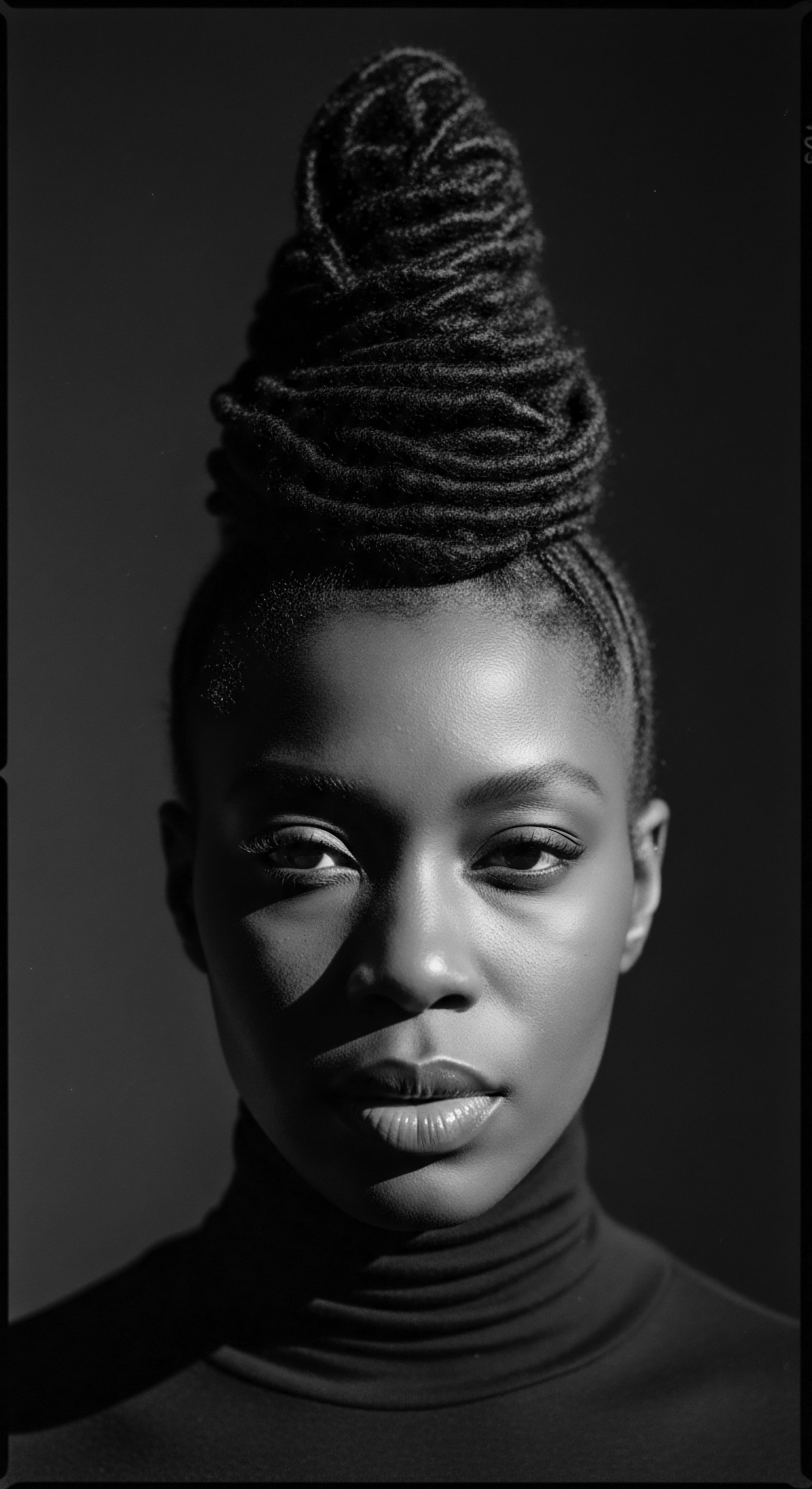
Fundamentals
The intricate arrangement of pigment within a hair shaft, known as Melanin Distribution, paints a profound narrative of human diversity and biological artistry. At its most fundamental, melanin, the very substance that bestows color upon our skin, eyes, and hair, finds expression in two primary forms ❉ Eumelanin and Pheomelanin. Eumelanin, a dark, brownish-black pigment, governs the spectrum of brown and black hues, while pheomelanin, a lighter, reddish-yellow pigment, lends its warmth to red and blonde tones. The proportion and presence of these two melanin types determine the ultimate shade of a hair strand.
Within the hair’s structure, tiny granules called Melanosomes house these pigments. These melanosomes are not simply scattered haphazardly; their spatial arrangement, their size, their shape, and their concentration within the hair’s cortical layer are what define the Melanin Distribution. For many textured hair types, particularly those deeply connected to African ancestral lineages, this distribution is often characterized by a higher density of eumelanin and melanosomes that are larger and more irregularly clumped or dispersed. This distinctive arrangement plays a significant role in dictating not only the rich, often dark, colors witnessed across the diaspora but also the inherent structural characteristics that lend textured hair its unique strength, elasticity, and ability to hold moisture.
Melanin Distribution, the unique organization of pigment within hair, shapes both the vibrant hues and the foundational strength of textured hair, echoing ancestral legacies.
This primary understanding forms the bedrock for appreciating the deeper meaning of Melanin Distribution beyond mere coloration. It speaks to the elemental biology that shapes our external presentation, a biological heritage passed down through generations.

The Pigment’s Silent Language
Each strand of hair whispers tales of genetic inheritance, its color a visual testament to the precise balance and placement of melanin. The varying ways melanosomes align along the hair shaft contribute to the hair’s perceived shade and its responsiveness to light. Hair with a dense, evenly spaced distribution of large eumelanin-rich melanosomes absorbs light readily, displaying deep, lustrous black or dark brown tones.
Conversely, hair with fewer, smaller melanosomes or a greater proportion of pheomelanin allows more light to scatter, resulting in lighter or reddish appearances. This silent language of pigment communicates a lineage of sun-kissed lands and resilient skin tones, deeply ingrained in the human story.
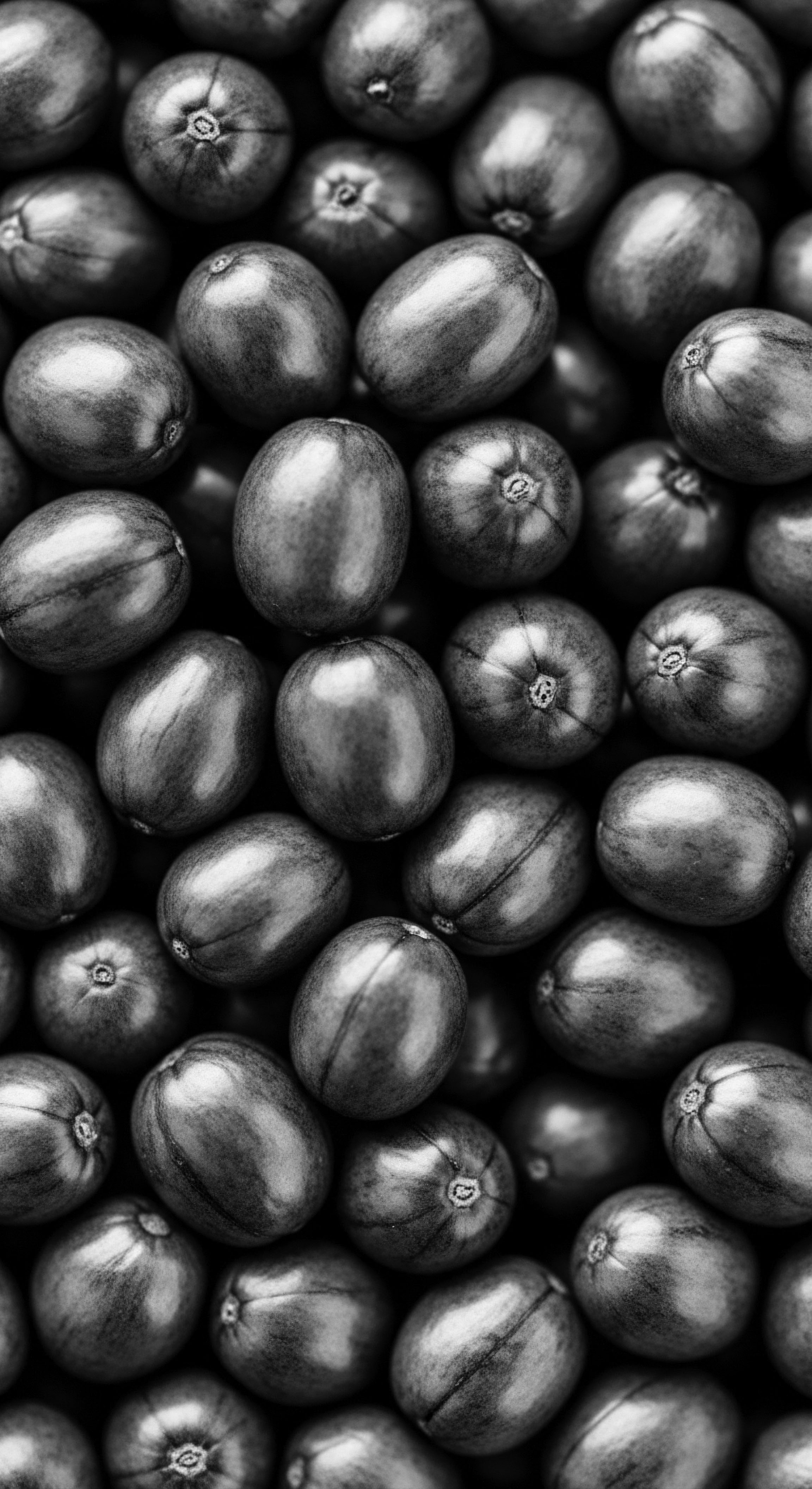
Elemental Forms of Beauty
Recognizing the elemental forms of melanin within hair allows for a profound appreciation of the diversity in human appearance. The beauty of deeply pigmented hair, often robust and resilient, reflects an adaptation to varying environmental pressures, including intense solar radiation. Ancestral communities, long before scientific laboratories could discern melanosomes, understood the resilience and unique properties of their hair.
Their hair care rituals, though born of practical need and communal wisdom, intuitively honored these inherent biological traits influenced by melanin’s arrangement. This recognition forms a foundation for understanding the historical context of hair care.

Hair’s Inner Landscape
The internal topography of each hair strand, its inner landscape, reveals how melanin is positioned. Melanosomes primarily reside within the Cortex, the hair’s central and thickest layer. In straight hair types, melanosomes tend to be uniformly distributed. For many textured hair types, these pigment granules can cluster unevenly, contributing to the hair shaft’s elliptical shape and its distinct curl patterns.
This non-uniformity influences how the hair reacts to moisture and external stresses. Appreciating this microscopic landscape allows for a deeper comprehension of why specific care methods have proven effective across generations for textured hair.

Intermediate
Moving beyond the foundational tenets, the intermediate meaning of Melanin Distribution centers upon its more profound impact on the structural integrity and textural characteristics of hair, especially within the vast spectrum of textured hair. The precise arrangement of melanosomes within the hair shaft significantly influences its shape, its strength, and its interaction with the elements. For hair types often associated with African heritage, the melanin distribution is not merely about color; it profoundly shapes the hair’s coiled architecture and its unique biomechanical properties.
The distribution of melanin can affect the hair’s tensile strength, its elasticity, and its natural predisposition to certain forms of breakage. Hair with a denser, more irregular distribution of melanosomes, typical of many tightly coiled textures, may possess a higher intrinsic tensile strength, yet its unique helical structure, influenced by the unevenness of these internal components, can create points of fragility at the bends of the coil. This duality has long informed traditional care practices, where protective styles and moisturizing regimens were employed to nurture and safeguard these specific structural nuances.
Beyond color, Melanin Distribution shapes the very architecture of textured hair, influencing its coiled strength and informing time-honored care traditions.

The Architecture of Each Strand
Consider the exquisite architecture of a single strand of textured hair. Unlike straight hair, which generally boasts a circular or oval cross-section, many textured hair types possess a flattened or elliptical cross-section. This distinctive shape arises, in part, from the uneven proliferation and arrangement of melanin granules during hair growth. In the context of textured hair, melanosomes may be more heavily concentrated on one side of the hair shaft or distributed in a more irregular, clustered manner.
This asymmetric internal arrangement can contribute to the hair fiber’s torsional twist and inherent curl pattern. Understanding this internal architecture provides a pathway to appreciating why certain natural humectants and emollients, long valued in ancestral hair routines, prove so effective in moisturizing and conditioning hair with these unique structural properties.

Light’s Dance Upon the Coil
The interplay between light and hair pigment presents another layer of understanding. Melanin Distribution dictates how light interacts with the hair strand, influencing its perceived luster and vibrancy. Hair with a more concentrated and uniform distribution of eumelanin tends to reflect light in a continuous, glossy fashion, appearing highly shiny. Conversely, textured hair, with its often irregular melanosome distribution and its distinct curl patterns, causes light to scatter rather than reflect uniformly.
This scattering yields a softer, diffused glow, contributing to the unique halo effect often observed around tightly coiled hair. This visual characteristic is a testament to the hair’s internal complexity and its deep connection to its ancestral source.
This phenomenon, the scattering of light, has long been admired in many cultures. It contributes to the visual richness of deeply pigmented hair, transforming light into a soft, diffused aura. Such characteristics informed historical preferences for certain hair adornments or styling methods that played upon this unique interaction with light, enhancing the hair’s innate radiance.

Echoes of Ancestral Care
The wisdom embedded in ancestral hair care practices often predates scientific understanding of melanin or keratin. Yet, these traditions, developed over centuries, intuitively addressed the unique needs arising from the specific Melanin Distribution patterns in textured hair. For instance, the widespread historical use of natural oils such as Shea Butter across West Africa (Adebayo, 2017) was not simply for aesthetic appeal.
These emollients provided a protective barrier, reducing moisture loss from hair shafts that might be more porous or prone to dryness due to their structural configuration, which in turn is influenced by melanin distribution. Such practices speak to a deep, inherent understanding of hair’s needs, passed down through generations.
Consider the careful preparation and application of these natural ingredients. Whether it was the rhythmic massaging of oils into the scalp to stimulate circulation and nourish the hair follicle, or the meticulous braiding and twisting of hair into protective styles, each action was an echo of an ancestral understanding that revered hair as a living extension of self and heritage. These rituals acknowledged the hair’s propensity for dryness and fragility at its bends, providing the necessary lubrication and protection.
- Shear Butter Application ❉ Historically applied to provide intense moisture and protect against environmental damage, directly addressing the common dryness associated with specific melanin distribution in textured hair.
- Baobab Oil Use ❉ Valued for its rich fatty acid profile, traditionally used to nourish the scalp and hair, enhancing the hair’s natural elasticity and resilience.
- Aloe Vera Preparations ❉ Utilized for its soothing and moisturizing properties, promoting scalp health which directly influences the growth of robust hair strands.
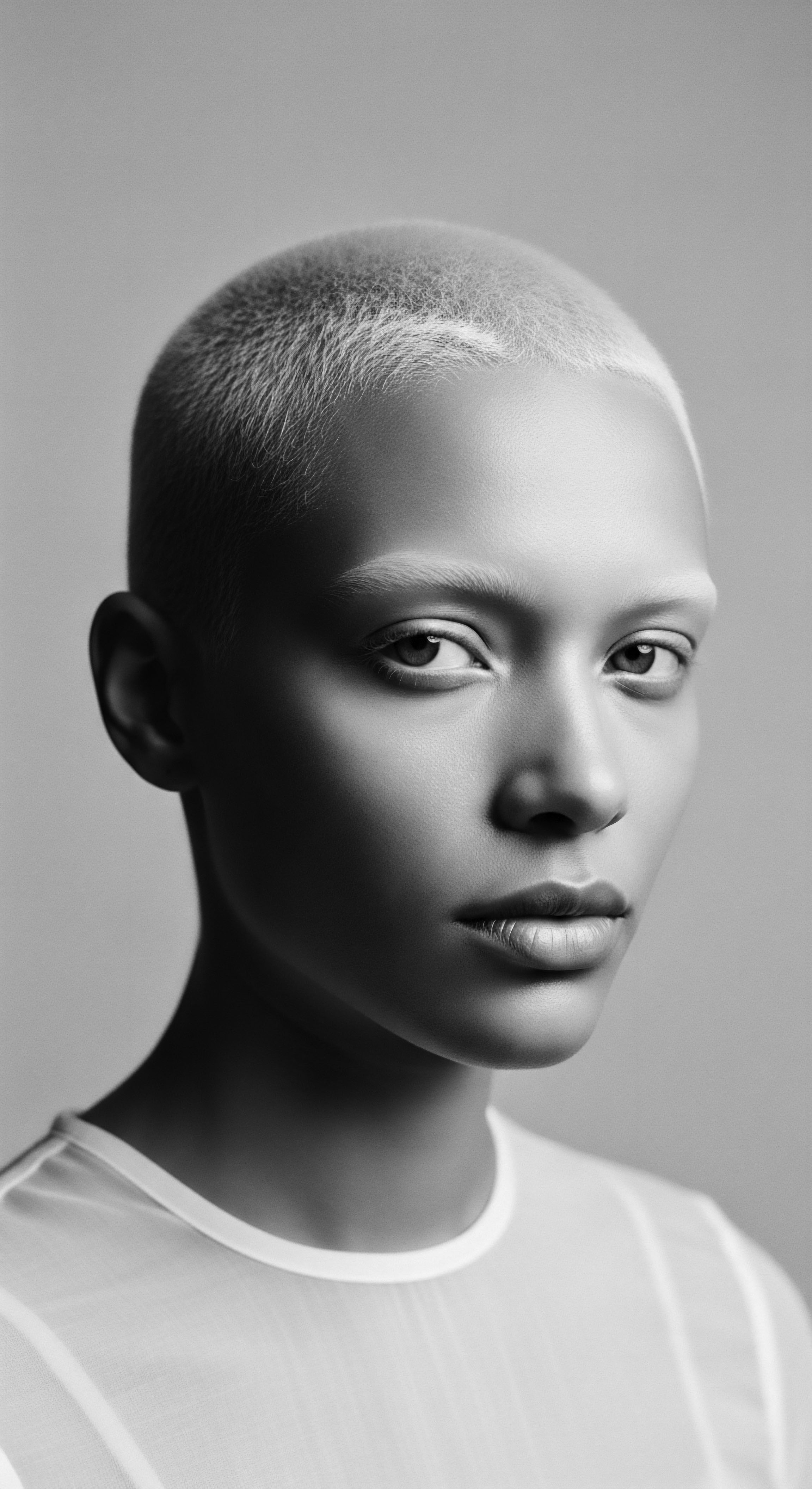
Academic
The precise delineation of Melanin Distribution, from an academic vantage, refers to the systematic organization, morphology, and concentration of melanin granules (melanosomes) within the cortex and cuticle of the hair shaft. This complex pigmentation pattern, largely determined by genetic predispositions, dictates not only the chromatic expression of hair but profoundly impacts its structural integrity, biomechanical properties, and response to external stimuli. In textured hair, particularly those phenotypes prevalent in populations of African descent, the Melanin Distribution manifests as a more asymmetrical or heterogeneous arrangement of melanosomes, often leading to a greater degree of torsion, an elliptical cross-sectional shape, and distinct coiling tendencies. This intricate internal architecture stands as a testament to evolutionary adaptations and presents unique considerations for hair science and dermatological study.
The meaning of Melanin Distribution, through a rigorous academic lens, therefore transcends simple color determination. It necessitates an examination of the precise cellular and molecular processes governing melanosome biogenesis, transport, and deposition within the hair follicle’s melanocytes. These melanocytes, residing at the base of the hair follicle, synthesize melanin and transfer it to keratinocytes, the cells forming the hair shaft.
The precise mechanism and regularity of this transfer contribute significantly to the ultimate distribution pattern observed in the mature hair fiber. Deviations in this process, or genetic variations influencing melanocyte activity, directly lead to the diverse spectrum of hair colors and structural properties seen across human populations.
Melanin Distribution, viewed academically, is the systematic organization of pigment within the hair shaft, profoundly shaping its color and biomechanical attributes, particularly evident in textured hair.

Defining the Melanin Distribution ❉ An Academic Lens
Academic inquiry into Melanin Distribution involves a rigorous assessment of factors contributing to its variability. Scientific investigations often employ electron microscopy to visualize the size, shape, and aggregation patterns of melanosomes. For instance, studies have shown that Eumelanosomes in African hair are typically larger, more ellipsoidal, and tend to aggregate in clusters compared to the smaller, more spherical Pheomelanosomes (Rebello, 2007).
This morphological difference, combined with their specific spatial distribution, imparts distinct light-scattering and mechanical properties to the hair. The consequence of this distribution extends to the hair’s hydration status, its susceptibility to photodegradation, and its overall manageability, making it a critical area of study for trichology and cosmetic science.
Moreover, the structural nuances imparted by Melanin Distribution are not confined to the cortex. The outermost layer, the cuticle, also presents distinct characteristics influenced by the underlying melanin patterns. In hair with a dense and clustered melanin distribution, cuticle scales may be more raised or irregularly overlapped, contributing to a coarser feel and potentially greater susceptibility to mechanical damage. This interplay between internal pigment arrangement and external cuticle integrity highlights the holistic nature of hair’s biological design, where every component contributes to its overall phenotype and resilience.
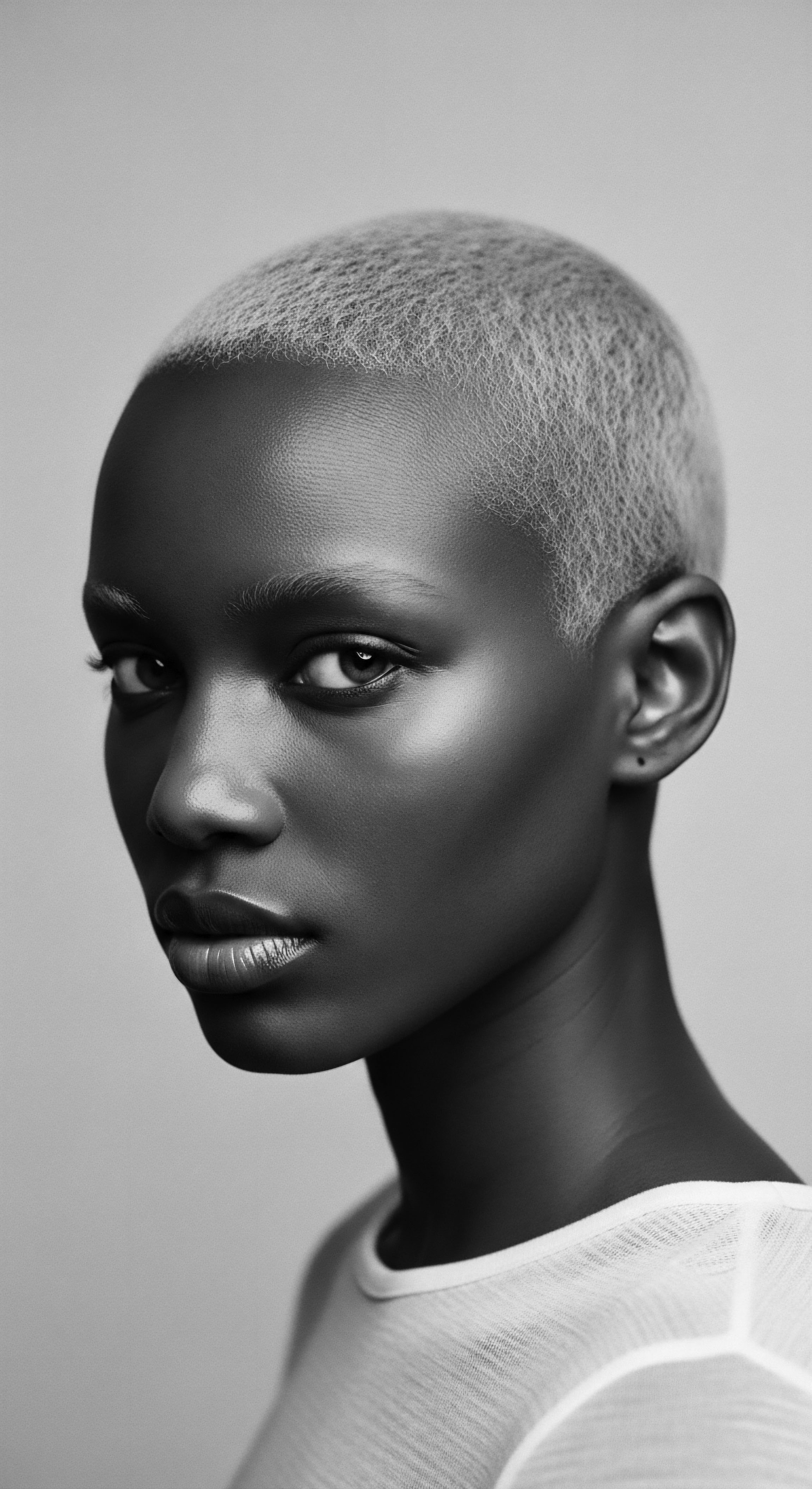
The Silent Architects of Resistance ❉ Cornrows as Cartography
A powerful historical example of Melanin Distribution’s understated significance lies in the ingenious ancestral practices of enslaved Africans. While not a direct scientific experiment, historical accounts and scholarly interpretations reveal how intricate cornrow patterns, particularly those originating from West African braiding traditions, served as covert cartographic tools and communication systems during the transatlantic slave trade (Byrd & Tharps, 2001, p. 19). The ability of these complex styles to hold their shape, their intricate pathways, and their discrete patterns relied intrinsically on the physical properties of highly melanated, densely coiled hair.
The unique biomechanical properties of textured hair, influenced by its distinct Melanin Distribution—specifically the robust nature of the hair shaft and its inherent ability to retain tightly woven configurations—made such secret mapping possible. The highly structured cortical layer, where melanosomes are irregularly clustered, grants these hair types a remarkable degree of tensile strength and elasticity, enabling them to withstand the tension of intricate braiding without breaking or unraveling quickly. This meant messages and escape routes could be literally ‘worn’ on the head, remaining hidden in plain sight. The historical meaning of these styles transcends mere aesthetics; they symbolize resilience, ingenuity, and a profound connection to an ancestral knowledge system that adapted to unimaginable duress.
| Traditional Practice/Hair Quality Cornrows as Escape Maps (Enslaved Africans) |
| Connection to Melanin Distribution & Hair Properties Relied on the inherent tensile strength and coil retention of highly eumelanin-rich hair, allowing intricate, durable patterns to be maintained. |
| Traditional Practice/Hair Quality Daily Oiling Rituals (West Africa) |
| Connection to Melanin Distribution & Hair Properties Addressed the greater propensity for dryness in hair with elliptical cross-sections and irregular melanin distribution, which impacts cuticle integrity and moisture retention. |
| Traditional Practice/Hair Quality Protective Styling (Diaspora Wide) |
| Connection to Melanin Distribution & Hair Properties Minimized mechanical stress at the delicate bends of coiled hair, a fragility linked to uneven melanosome density and the resulting hair shaft curvature. |
| Traditional Practice/Hair Quality These historical practices reveal an intuitive understanding of hair's properties, deeply tied to its pigmentary and structural makeup. |
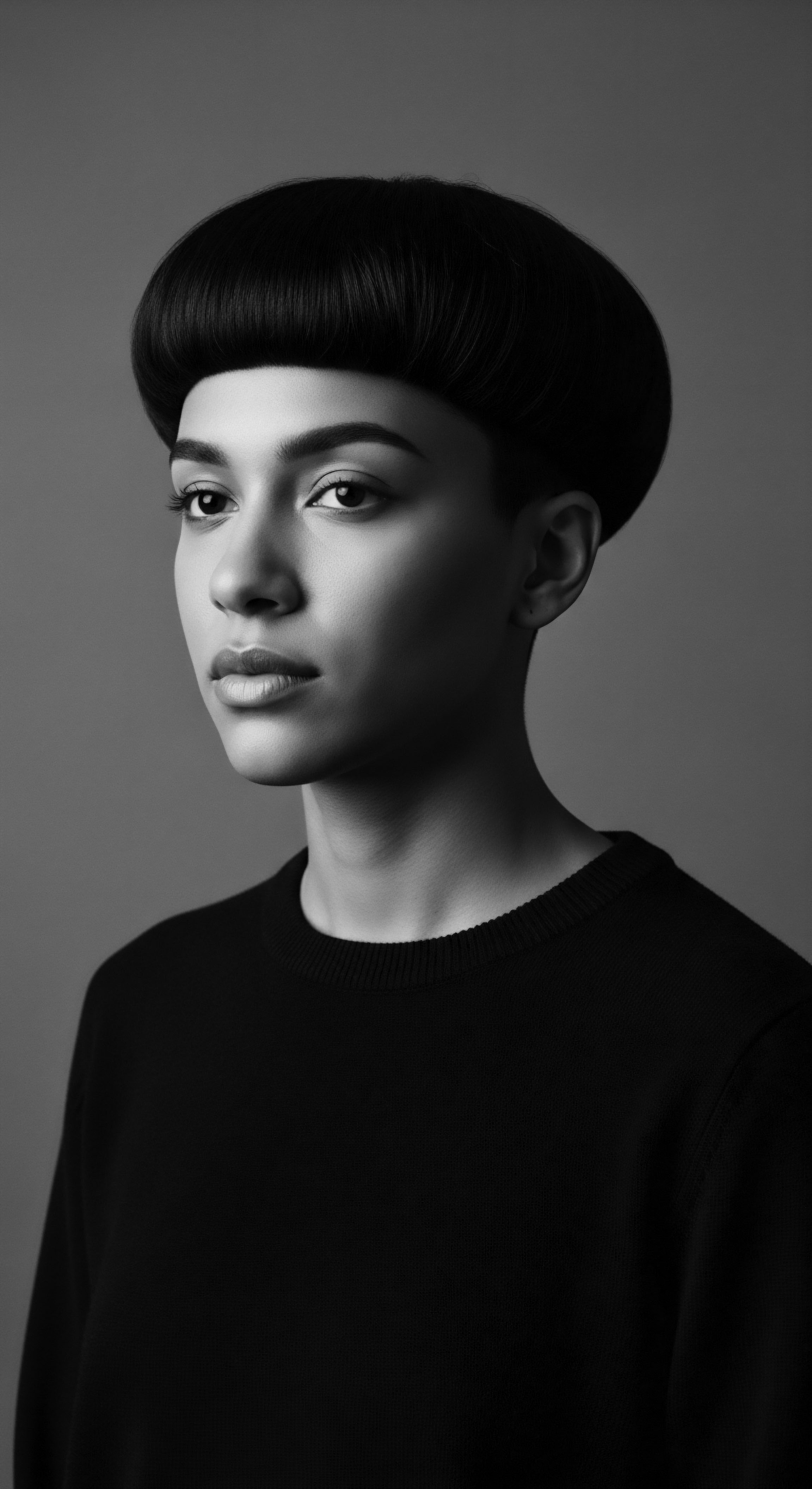
Biomechanical Realities and Ancestral Wisdom
Delving further into the biomechanical realities, the specific Melanin Distribution in textured hair has profound implications for its interaction with chemical treatments and environmental stressors. The higher concentration of eumelanin offers superior protection against UV radiation-induced damage compared to pheomelanin-rich hair (Jules-Rosette, 1990). However, the irregular distribution of melanosomes can also contribute to variations in hair porosity along the strand, influencing how chemicals penetrate the hair cortex. This nuanced understanding helps to explain why certain chemical processes, like relaxers or dyes, may react differently on textured hair compared to other hair types.
Ancestral wisdom, passed down through oral tradition and lived experience, often mirrored these scientific realities. The emphasis on gentle manipulation, the avoidance of harsh chemicals, and the reliance on natural ingredients found in the local environment were not coincidental. These practices were a direct, albeit unarticulated, response to the intrinsic properties of highly melanated, textured hair.
They understood that this hair, while remarkably resilient in its natural state, required careful tending to maintain its integrity against the rigors of daily life and environmental exposure. This historical ecological understanding of hair care is a rich area for academic exploration.

Variations Across the Human Tapestry
The human tapestry is woven with countless variations in hair type, each bearing the distinct mark of its Melanin Distribution. While this discussion centers on textured hair with its often high eumelanin content and specific distribution patterns, it is crucial to recognize the spectrum. Hair types categorized as East Asian, for instance, typically possess very high eumelanin content, but their melanosomes are uniformly distributed, leading to strong, straight strands. European hair types exhibit the widest range of melanin levels and distributions, accounting for the vast array of blonde, brown, and red hair.
The implications of these global variations for hair care, product development, and even cultural identity are extensive. Understanding that Melanin Distribution is not a monolithic concept, but rather a dynamic continuum of patterns, allows for a more respectful and informed approach to hair care across all human populations. It underscores the shared biological underpinnings of human diversity while celebrating the unique expressions of hair heritage.

Reflection on the Heritage of Melanin Distribution
To truly comprehend Melanin Distribution is to embark upon a contemplative journey through time, bridging elemental biology with the enduring spirit of ancestral wisdom. This exploration has, in essence, been a profound meditation on the scientific realities that shape hair and the rich cultural narratives spun around its care. From the microscopic architecture of the melanosome to the grand tapestry of human heritage, melanin’s deliberate placement within each strand tells a story of resilience, adaptation, and beauty.
The narrative of textured hair, deeply rooted in Black and mixed-race experiences, becomes vibrant when we recognize the scientific underpinnings that have always been present. It is a powerful affirmation that the qualities of hair—its profound color, its strength, its unique coiled patterns—are not random occurrences but purposeful expressions of genetic legacy. The very essence of what makes textured hair distinct is intricately linked to the precise, often irregular, distribution of melanin within its fibers. This understanding fosters a deeper reverence for one’s own inherited hair, transforming care rituals into acts of honoring lineage.

Honoring the Genetic Legacy
Honoring this genetic legacy means recognizing the historical ingenuity of our ancestors who, without scientific instruments, developed sophisticated systems of hair care. Their practices, whether through the meticulous application of natural oils or the creation of protective styles, were an intuitive response to the biomechanical realities of their hair, realities shaped by Melanin Distribution. This continuity of care, from ancient communal gatherings to modern conscious choices, underscores a living heritage. It invites us to pause and consider the hands that shaped these traditions, the wisdom passed from elder to youth, and the enduring connection to the earth and its bounties.
To embrace Melanin Distribution in this light is to appreciate the intrinsic value of every coil, every kink, every curl. It is to move beyond imposed beauty standards and find profound beauty in the natural expression of one’s hair. This journey of understanding brings about a sense of belonging, a tangible link to those who came before, and a celebration of the unique biological heritage that defines us.
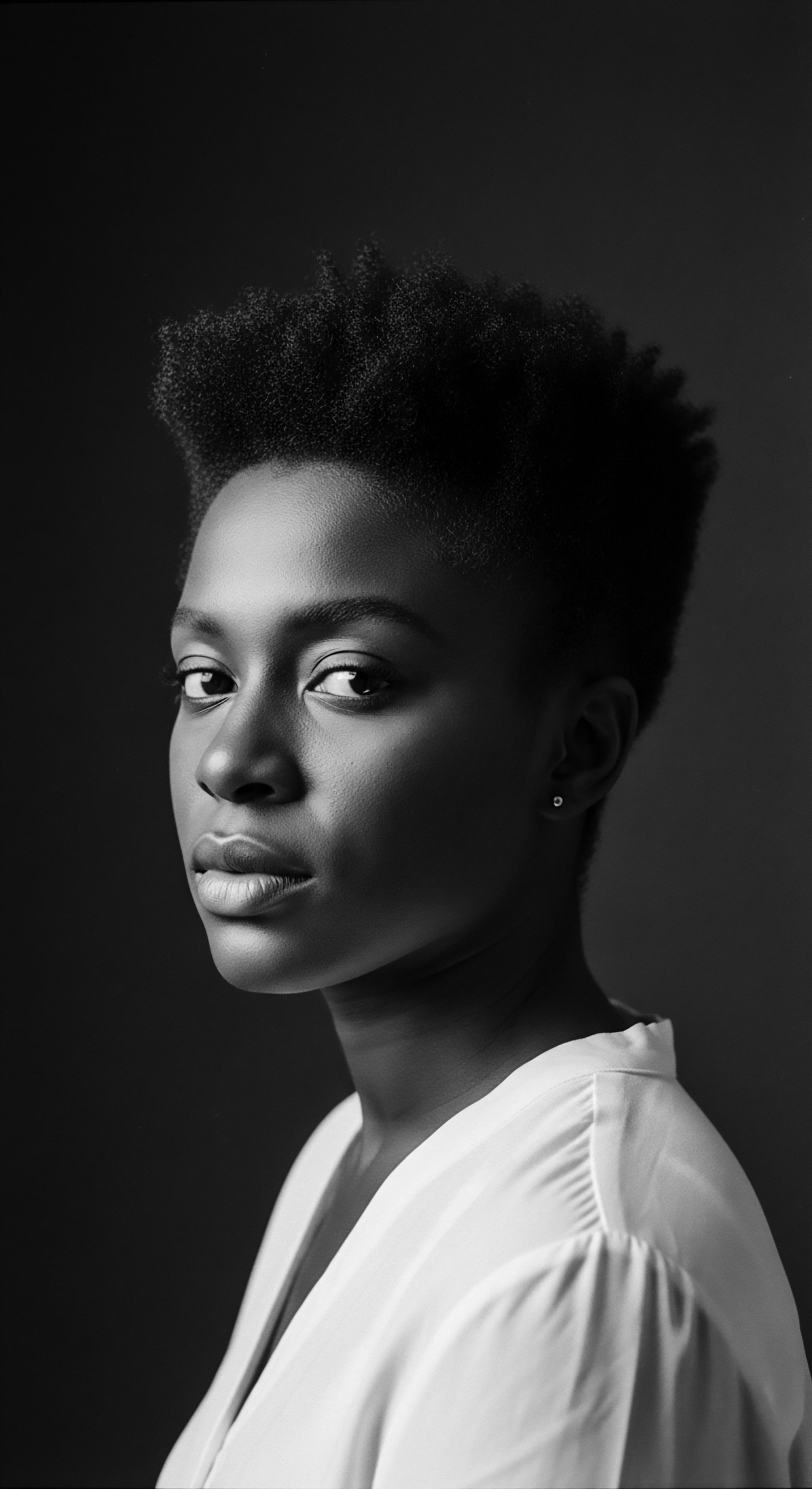
Beyond Science ❉ The Soul of the Strand
While science offers invaluable explanations, the true meaning of Melanin Distribution, particularly for communities with a deep hair heritage, extends beyond mere chemical composition. It touches upon the soul of the strand itself. Each hair fiber carries not just pigment but generations of stories—of resistance, triumph, artistic expression, and self-definition. The way light plays upon a crown of deeply pigmented, coiled hair, creating a soft halo, speaks to an inner radiance that has been cultivated and celebrated for centuries.
This perspective empowers individuals to view their hair not as a challenge to be conquered, but as a sacred vessel, a living archive of identity and ancestral memory. It transforms hair care from a chore into a communion, a daily ritual that connects the present self with a vast and resilient past. This deep connection to heritage, facilitated by an understanding of Melanin Distribution, allows for profound personal and collective healing, reshaping narratives around beauty and belonging.
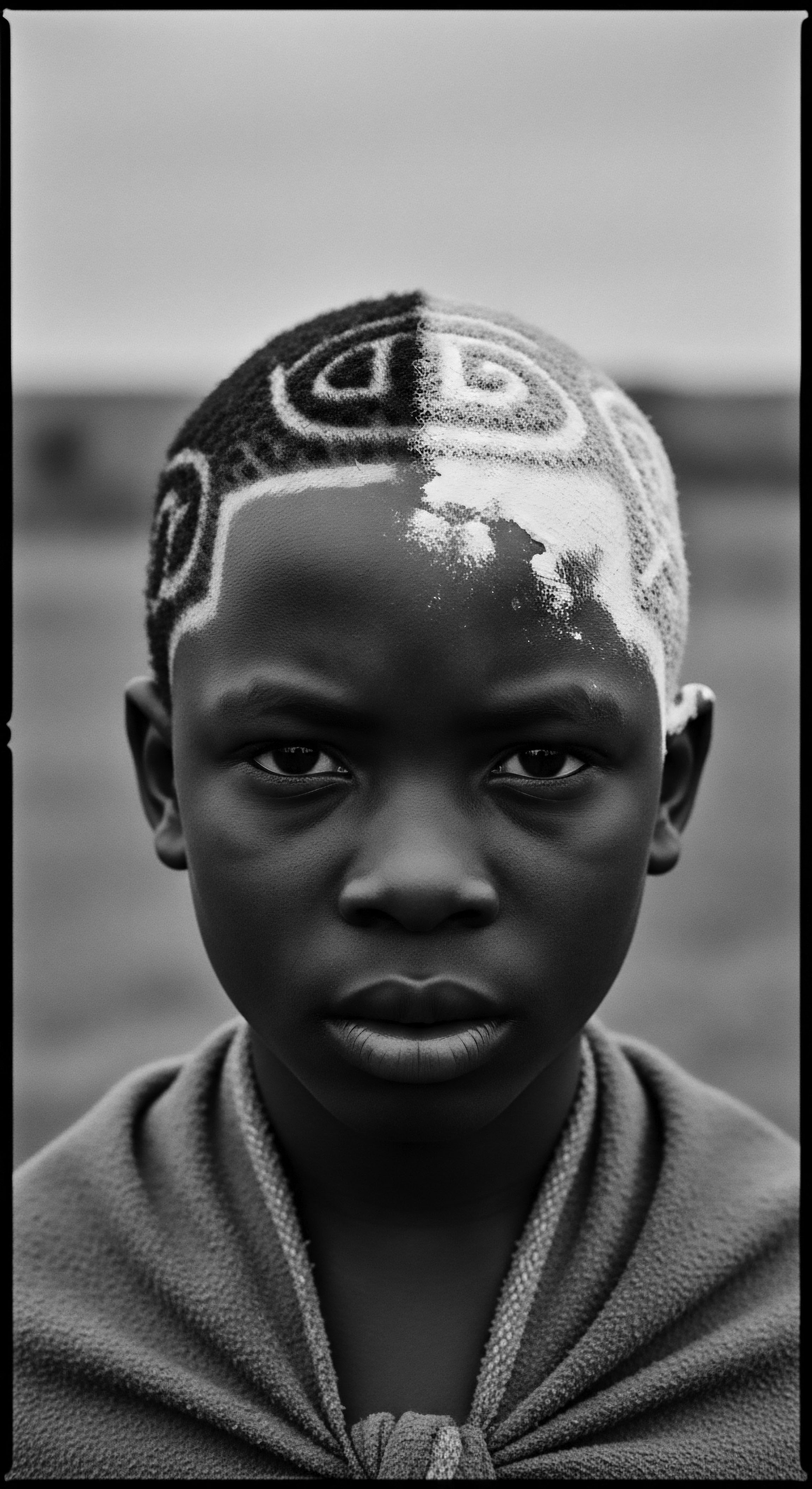
A Future Woven from the Past
The path forward, illuminated by a holistic understanding of Melanin Distribution, sees a future for textured hair care woven directly from the threads of the past. It means advocating for products and practices that respect the unique structural properties of melanated hair, guided by both scientific rigor and ancestral wisdom. It is a call for a continuous dialogue between tradition and innovation, where new discoveries validate ancient truths and where cultural pride is integrated into every aspect of hair wellness.
Ultimately, comprehending Melanin Distribution offers a profound sense of self-acceptance and affirmation. It reminds us that our hair is a natural masterpiece, a gift from our forebears, deserving of honor, care, and celebration. This heritage-centered approach empowers us to stride confidently into the future, carrying the stories of our hair with grace and profound appreciation.
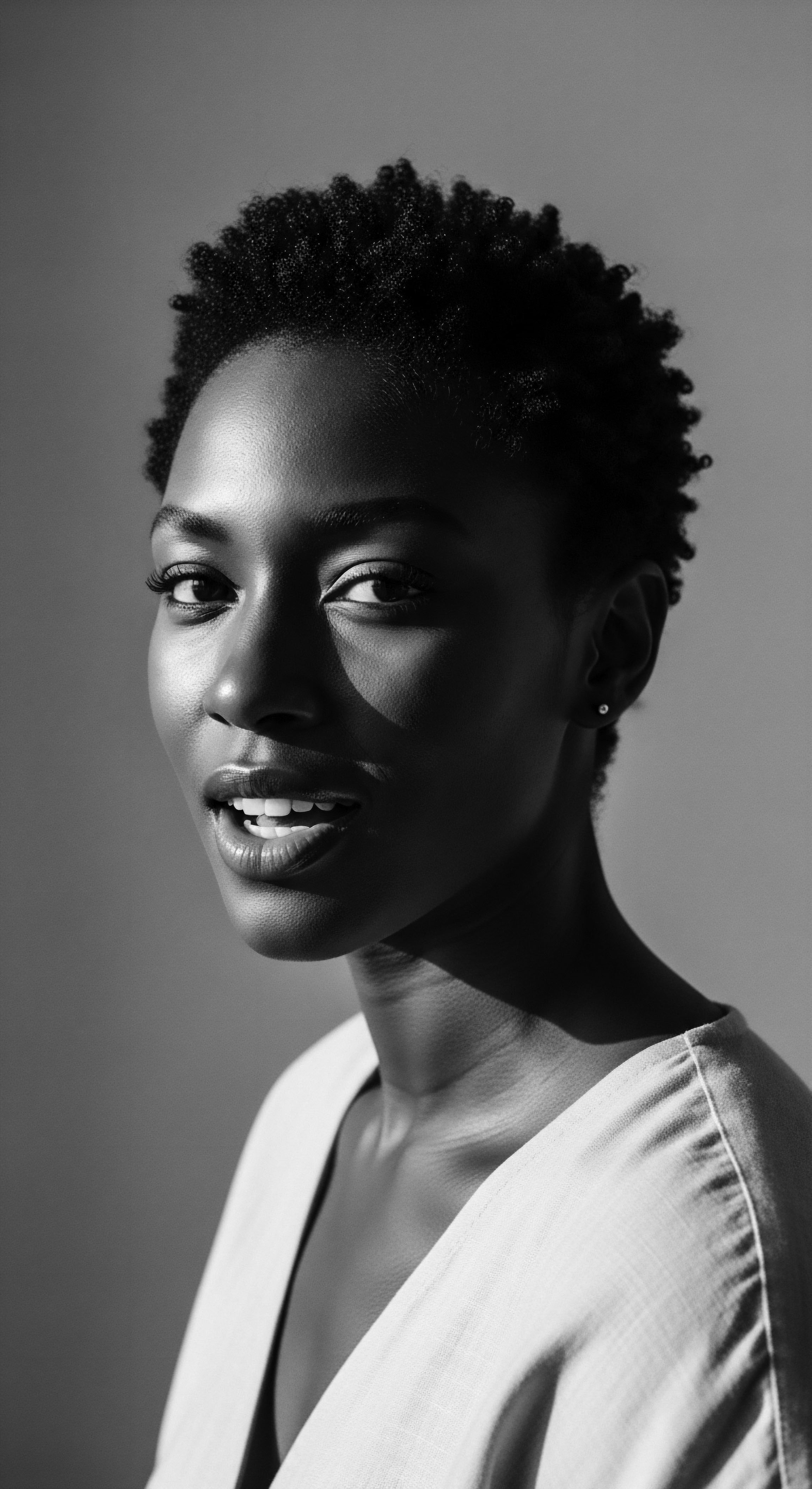
References
- Byrd, Ayana, & Tharps, Lori. (2001). Hair Story ❉ Untangling the Roots of Black Hair in America. St. Martin’s Press.
- Adebayo, Akin. (2017). The Global Shea Butter Industry ❉ A Market Study. Createspace Independent Publishing Platform.
- Jules-Rosette, Bennetta. (1990). Black Paris ❉ The African Writers’ Landscape. University of Illinois Press.
- Rebello, Trisha. (2007). Hair Color ❉ Its Chemical and Biological Aspects. CRC Press.
- Pittman, Kimberly A. (2008). Hair ❉ A Cultural History. Simon & Schuster.
- Opitz, Mayra. (2014). Black Hair ❉ A Cultural and Aesthetic Perspective. Routledge.
- Nelson, Lynn. (2013). Hair in African-American Culture. Palgrave Macmillan.
- Mercer, Kobena. (1994). Welcome to the Jungle ❉ New Positions in Black Cultural Studies. Routledge.
- Banks, Ingrid. (2002). Hair Matters ❉ Beauty, Power, and the Politics of African American Women’s Hair. New York University Press.
- Grier, William H. & Cobbs, Price M. (1968). Black Rage. Basic Books.
